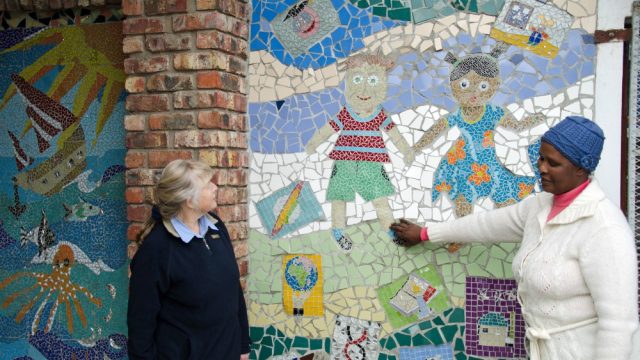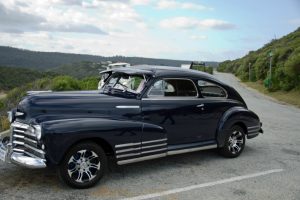This is my father’s cup of tea I think, stepping into the car. Riding in a 1948 Chevy, a deep shade of midnight blue with its lines long and sensuous, we amble slowly along the main road in Sedgefield, a town on the Garden Route. Sheridan Renfield, owner of Sedge Classic Cars is driving me around, gently warming the motor of the beautiful automobile as he accelerates progressively – each car is different, he says. People stare, Mr Renfield waves, and I settle into the comfortable chocolate leather seats, talking in the levers and gadgets on the interior. If time were a test, they have endured.
We’re meant to go for a short ride up to the petrol station but as we chat about the town and its charms we keep driving until we’re at the Sedgefield estuary mouth, close to the colourful mosaic of a large fish, and then to visit The Island where Mr Renfield and his wife live. Having been involved in the classic car industry for most of his adult life, he runs Sedge Classic Cars, a well-known and popular sight on the main road between George and Knysna.
According to Mr Renfield, Sedgefield is still the best-kept secret in the Garden Route.
“There’s a friendliness amongst the residents and my fellow workers that makes me proud to live in this beautiful part of South Africa. Miles of unspoilt beaches too,” he says
And thus begins my introduction to Sedgefield, Africa’s first and only certified Cittaslow town or “slow town,” a concept that derives from the slow town movement in Italy, which in turn took its inspiration from the Slow Food concept. There are in total 189 cities across 29 countries that are official slow towns. On previous visits I’ve never lingered beyond a quick stop at the popular Saturday market.
Cittaslow Status
There is a lengthy manifesto the town must abide by in order to qualify for the Cittaslow status, which is scrutinised by the head organisation. Founding member and local businessman André Gauché says, “Slow living comes naturally to the residents. Sedgefield has breath-taking beauty, active environmentally conscious residents, a small sustainable population, no heavy industry and a caring community.”
The list of qualifying requirements is long and includes preserving traditional food, controlling growth, living a healthy lifestyle and working towards a sustainable future.
Greg Vogt, CEO of Knysna Tourism, under whose jurisdiction the town falls, says that the attitude of the town as a whole gives the Cittaslow initiative a type of integrity that brand managers dream of.
“The people of Sedgefield whole-heartedly embrace the concept, “ he says, “They love the values and live by them.”
Making Haste Slowly
Sedgefielders, with Slow, the giant mosaic-ed tortoise as their resident mascot, take pleasure in “making haste slowly” and living more consciously. No one is rushing on the streets; there is no traffic to speak of.
At first I’m not entirely convinced that, outside the lives of retirees, of which there are a great many living here, businesses can be run successfully by adhering to this model of “slow”, “easy” and “leisurely”. Who can make a buck or meet a deadline at this pace, I wonder. When I arrive at a coffee shop on the main road at eight-thirty, one morning, ready to get some work done, the owner is yet to set up. Her neighbour enters, helps her to arrange the tables and chairs and leaves with a cheery farewell. Everyone I accompany is greeted by name wherever we go. With a population of around 8000 permanent residents, a figure projected not to exceed 15 000, Sedgefield is a village. One, where everyone knows your name.
The Mosaic Route
Sophie Nguma greets me shyly at our meeting point outside the tourism office. It’s her first day as a tour guide on the Mosaic Art Tour, and she tells me she got absorbed into the craft five years ago, in need of a job. She was visiting Masithandane an NPO that works in the Eden district on a variety of projects from running a clinic mainly for HIV/AIDS patients and a day care centre to teaching skills to an impoverished section of Sedgefield’s population. The mosaic lessons were an effort to generate funds to support Masithandane’s work and to teach unemployed men a new skill. Sophie decided if the men could do it, so could she and today she is an essential member of the team.
Together with Jackie Weaver who assists with many of Masithandane’s projects, we drive across the town from the centre out to Smutsville, around the beaches and to The Island, to a total of 40 mosaics. Some have been commissioned by the city, others are privately requested pieces like benches in memory of a loved one, and they comprise the town’s effort to be South Africa’s first mosaic town. The works, usually covering hefty cement shapes range from bright and naïve to complex and intricate. The war memorial in Swallow Drive depicts a scene of poppies on the fields of Flanders with white crosses and bears the qualities of a great painting. It’s one of Sophie’s favourite pieces, along with the children’s library mural in Smutsville, an educational heritage mosaic that involved 200 children from the school.
“You must be relaxed and patient when you do this. You get better with practice,“ she says as I marvel at the tiny glass tile cuttings.
Good Food Slowly
Rose Brettell and Susan Garner who founded the Wild Oats Community Farmer’s market in 1999, one of Knysna’s most famous attractions, place an emphasis on moving away from the “convenience-culture” representative of current societal norms. Showcasing food produce and products from within a 50-kilometer radius, the focus is on education, community and ethical pricing. There is a drive to ensure that only local products are used by the fresh food vendors – farm butter over margarine, freshly pressed juices over soft drinks, stone ground flours, no GMOs or additives.
For Brettell and Garner one of the greatest benefits of a slow town is the sense of belonging and responsibility to one another.
“The market provides the perfect setting for this with slow food made with care, the antithesis of fast-food. Wild Oats encourages you to eat together and become a vital, caring community,” they say.
One of the challenges has been in getting more township dwellers to the market. The price point is fair but it boils down to transport, Garner says. All efforts to organise a taxi service have come to naught.
The Slow Festivities
From Gerickes Point, which provides a magnificent vantage over the town, and where paragliders launch into the sky, I wonder why so many people just drive through the town onwards to Knynsa. Like me, perhaps they aren’t aware of what lies above and beyond.
Amanda Dixon, event organiser of the Slow Festival, which happens each Easter says the event was created to draw people into the town. Over three days, with a host of activities from making anything that will float on the river to a fashion parade with clothes designed from recyclables, the town unites with bright orange storefronts that passing cars are compelled to notice.
The Future is Slow
Repeatedly I hear about an unflagging community spirit. You can’t be ill or grieving without someone bringing you a pot of soup or calling around with support, I’m told.
Across the economic divide, plans have been put in place by the tourism board and local initiatives to continue to strengthen the community through education and environmental initiatives like the Biowise project that grows mushrooms from used coffee grounds.
Progressively, Sedgefield is incorporating the principles of a forward-thinking, sustainable society based on slowing down and waking up.
Essential Info
Stay:
Lake Pleasant Living: http://www.lakepleasantliving.com/
Abundant Life: http://www.abundantlife7.co.za/
Dempsey’s Guest House: http://dempseys.co.za/
Do:
Sedge Classic Cars: http://www.sedgeclasscars.com/
Tourism Office for tours: http://visitknysna.co.za/
Slow Festival: http://www.slowfestival.co.za/
Masithandane: http://www.masithandane.org/
Biowise: http://www.biowise.org.za/


